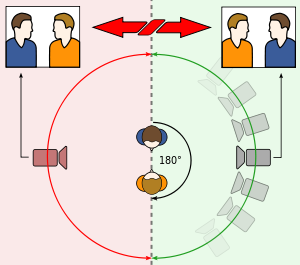- when talking to a camera (breaking the 4th wall)
- fancy edits- unrealistic
- no sense editing
A rule of continuity editing is the 180 degree rule this is when the camera can only move around the 180 degree angle around the people talking and cannot break it. When it's broken it can confuse the audience. 

Another technique used is shot reverse shot, this is where the camera cuts from one subject to another, this is normally done when filming of people talking. We used this technique often in the 'Oceans 12' task we were given, instead of zooming out as we thought it would be more interesting to see the facial expressions of the actors close up.
Match on action is also used, this is done when something happens in the scene then there is a cut to the action that must be going on.
Cross cutting is where it alternates between shots occurring simultaneously in two or more different locations. We used this technique when we were trying to create the spooks storyboard.
Eyeline match is a cut between two shots, where the first person is looking in one direction, and then in the next shot we either see what the person is looking at or another person looking back in the exacts same direction.
In continuity editing an establishing shots are used, this is done to show where it is, what time it is and who's in the scene-spatial relations between important characters.
Graphic match is where the scene cuts from A to B using objects that have the same shape. For example in The Mummy there is a literal shape match used.


















